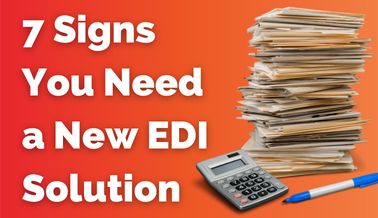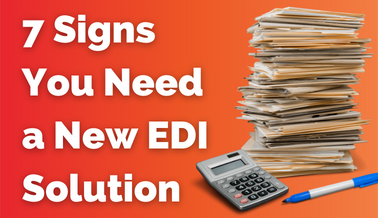Is it Time for a New EDI Solution? Here’s How You Can Tell.

December 8, 2022
Electronic Data Interchange is a great way to automate the exchange of impo
The fact is, not all EDI solutions are equal. And if you’re using the wrong provider, EDI might be costing you too much, while leaving you behind the competition. Wondering if it’s time to upgrade? Here are seven signs you need a new EDI solution.
#1: Your Solution Isn’t Integrated
Small businesses with low volumes often choose non-integrated EDI to save money, while allowing them to trade with retailers more easily. The downside is that non-integrated solutions create information silos. So, while your business can use EDI transactions, incoming and outgoing messages need to be transferred between your ERP and EDI systems manually. That’s fine when your business is small, but as you grow, it can become time-consuming and error-prone, bottlenecking your scalability.
Integrated EDI eliminates this issue by connecting directly with your ERP system, fully automating document exchanges and allowing your team to manage by exception. Moving to an integrated EDI solution might be right for you if:
- You experience high volume in EDI transactions
- You’re managing accounts with several or dozens of retail trading partners
- You need to access multiple partner portals to retrieve orders and update shipping information
- You have limited personnel and time resources to manually enter data
#2: You Still Have Missing Documents, Errors, other Trading Issues
No EDI system is flawless; not yours, and not your customers’. This means that sometimes documents go astray, or don’t contain all the information they need to. But some EDI solutions won’t tell you when something is missing, and that’s a big problem.
Sportsman’s Supply had to deal with that with their previous EDI system, reporting, “Sometimes a transaction might fail, and we wouldn’t receive a notification.” When this happened, the Sportsman’s Supply team had to manually enter the system, find the failed transaction, and figure out how to fix the data—by hand.
Sound familiar? A better option is an EDI solution that automatically notifies you of any transaction issues, from missing documents to errors, and tells you exactly what needs to be fixed to continue the order process. The best EDI solutions go a step further, reaching out to customers on your behalf to fix EDI document issues before they even reach your desk.
#3: The System Can’t Keep Up with Your Growth
Along the same lines of non-integrated EDI, you might have an older EDI solution that limits your scalability. For example, on-premises EDI solutions that leverage on-site servers are popular for businesses that want complete control over their solution. That’s great, except: what happens when your business outgrows the power of those servers? More volume needs more space, and with on-premises, that means more hardware to store and maintain.
On the other hand, what if you have all these servers, but you only have high volumes sometimes—for example, if your products are highly seasonal. In that case, you might be left paying for software, hardware, and IT resources you aren’t using a majority of the time.
Perhaps you’re already using a web-based EDI system. Now you need to consider the type of Network your solution uses. Here’s why:
- Value Added Networks (VANs) are one of the oldest methods of transacting EDI documents, but like non-integrated EDI solutions, require manual checking and document processing by the recipient.
- Single Channel Networks are great for EDI specifically, but don’t support other types of transactions, which makes it difficult to expand across new sales channels like eCommerce stores and drop shipping programs.
So, what’s the answer? For the best scalability and flexibility, look for a cloud-based solution that operates on a multienterprise commerce network. Cloud-based EDI ensures you can scale both up and down as order volumes change. At the same time, a commerce network offers the one-to-many functionality you need to trade with partners across multiple demand channels, all from a single platform.
#4: You’re Upgrading Your ERP System
If you’re already upgrading your accounting system, now might be the perfect time to leave behind your legacy EDI system. Here’s why: many older or less competitive EDI solutions require a complete overhaul when you change your ERP.
You read that right. With some EDI systems, changing your ERP could mean rebuilding your entire integration, and updating the EDI maps for every one of your supply chain partners. In fact, ERP upgrades are one of the most common reasons for businesses to replace their EDI solutions, for this very reason.
To prevent running into this problem in the future, make sure your new EDI provider offers plug-and-play EDI solutions. These solutions can be easily updated to integrate with a new ERP system, without disrupting your EDI instance, or requiring mapping updates.
#5: It’s Too Difficult to Manage Internally
If your EDI solution requires internal management and maintenance of software or hardware (in on-premises cases), it might be time to move to a new provider. Yes, managing EDI internally might seem like a money saver, but in the long run, it’s costing your business time and resources. What’s more, some solutions may require you to manage and maintain maps, which are crucial for staying EDI compliant. To be successful in, you’d need a dedicated EDI team, which can be expensive.
Managing EDI internally can also present issues like:
- Having out-of-date maps that cause issues with trading partners
- Not being able to take on new partners because you lack internal IT resources
- Taking too long to onboard new customers, losing out on potential sales
- Straining your IT team, leaving little time for them to address other business problems
“In the first year, we saved 10-12 hours per week, which gave our employees time back to work on real customer issues. It adds up—that’s more than 500 hours per year saved.” – Masterfit Enterprises
#6: You’re Overpaying
This one seems obvious, but it can be tricky. That’s because a lot of EDI providers make themselves “look” more affordable by having low startup fees. In the long run, these EDI solutions cost more because of fees for everything from your number of trading partners, to overage charges for excess transactions, to user charges.
Instead of looking at upfront fees, compare your costs over the last 3-5 years with your current solution, to the total cost of ownership with a new EDI solution over the next 3-5 years. Be sure to look at both set-up fees and recurring fees, and read the fine print in prospective providers’ SOW for hidden charges.
#7: Poor Service & Support
An EDI solution with no support (typical of SaaS solutions), or sub-par service can leave your business with an overworked IT department and unhappy trading partners. And let’s be clear, a fast pickup on your phone call doesn’t mean you’re getting the best service. Here are some common support and service issues that lead customers to seek new providers:
- New customer onboarding takes weeks (or months), and requires heavy lifting by your team
- The person who picks up the phone is at a call center, and doesn’t know anything about your business or ERP
- Endless holds and transfers on the phone. You can never seem to talk to the same person, so no one really gets to know your business needs
- Custom processes aren’t supported, or when you ask for them, they never seem to get done
- Support doesn’t include monitoring for trading partner map updates to help you stay compliant
- Your provider doesn’t ensure security with redundancy and disaster recovery in case of emergency
- Your contract isn’t being fulfilled; your integration doesn’t work properly or your implementation is taking far too long, preventing you from trading via EDI successfully
- You feel treated like a number, instead of a person
A better option than stewing in your frustration is finding a provider that offers a fully managed service approach, complete with 24/7 customer support availability, best-in-class security, and continuous, proactive EDI monitoring.
Ready for a New EDI Solution?
If you’re tired of a solution that doesn’t fit your brand’s future, the time to switch is now. With TrueCommerce, businesses like yours have saved more than 30% on EDI costs, while getting better service and complete integration with all their channels. To learn more, reach out to us today to speak with an in-house supply chain expert.
About the Author: Lindsey McGee is a Marketing Content Writer specialising in supply chain strategy, thought leadership, and education. As part of the Marketing team at TrueCommerce, Lindsey strives to provide thoughtful, accessible information to help business owners grow and manage their operations. Lindsey lives in Pittsburgh with her husband, Cody, and rescue pets, Delta, Bahn, and Izzie.
Share this post:
Categories
Stay ahead of the competition
Get expert supply chain insights delivered directly to your inbox weekly.
